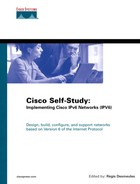IPv4 Address Space Exhaustion
The work on IPv6 at the IETF started when a preliminary study in 1990 concluded that the IPv4 address space would be exhausted. More specifically, the IETF predicted that Class B would be exhausted within four years (1994). This study also identified the necessity to assign several adjacent Class C addresses instead of Class B addresses to organizations. Class C addresses are small, but there are plenty of them (2,097,152).
NOTE
Class C is a block that represents 255 IPv4 addresses, whereas one Class B means 65,536 IPv4 addresses. However, in reality, 253 hosts can be addressed on a Class C.
The main technical constraint of that orientation was preserving the global Internet routing table size while keeping it from exploding. With several thousand routes in the global Internet routing table, the addition of hundreds of thousands of new small routes (Class C) was an important issue to avoid. Therefore, the CIDR mechanism adopted in 1992 was put into place to summarize adjacent blocks of IPv4 addresses in one block. CIDR has helped control the growth of the Internet routing table since 1993.
Figure 1-2 shows the global Internet routing table growth since 1989 (active BGP entries). In 2001, the total number of routes was more than 100,000, then later in 2003 it was 140,000 entries (a 40% growth within 24 months) If you want real-time information about this routing table, look for a route server on the Internet. Some of these route servers are freely available for public information and debugging purposes.
Figure 1-2. Global Internet Routing Table Growth Since 1989
Source: BGP Table Statistics, Telstra web site, www.telstra.net/ops/bgptable.html

Example 1-1 shows the global Internet routing table on a route server.
Example 1-1. Looking at the Global Internet Routing Table on a Route Server
In Example 1-1, the highlighted line shows 117,228 network entries, which is the total number of routes, 2,373,589 paths, which is the number of BGP AS-PATH entries, and 116,277,944 bytes of memory, which is memory used on that router to handle the routing table.
Another study done by the IETF tried to predict how long it will be before the IPv4 address space is exhausted. This study projected the unavailability of new IPv4 address space between 2005 and 2011. The perception of these results was mixed and contested. Some people argued that the projection was pessimistic, and others thought it was optimistic.
